|
|
|
Sort Order |
|
|
|
Items / Page
|
|
|
|
|
|
|
| Srl | Item |
| 1 |
ID:
144545
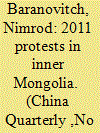

|
|
|
|
|
| Summary/Abstract |
In May 2011, Inner Mongolia experienced the most serious ethnic unrest in the region for 30 years. In this article, I explore the broader context that led to the eruption of the protests, with a particular emphasis on environmental issues. My aim is to explain why environmental issues occupied such a prominent position in the protests, and how these issues were connected to ethnicity. After discussing the material and practical implications of grassland degradation for Mongolian herders, I analyse the symbolic implications of this environmental crisis for the Mongolian educated elite, who have linked environmental issues to ethnic politics and identity. I argue that in the last 20 years or so, Mongolian intellectuals have developed a highly ethnicized environmental discourse, and that this discourse played an important role in informing the 2011 protests. My analysis focuses on this discourse as it is manifested in the domains of art, academia and daily discourse.
|
|
|
|
|
|
|
|
|
|
|
|
|
|
|
|
| 2 |
ID:
138475
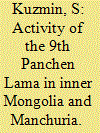

|
|
|
|
|
| Summary/Abstract |
This article describes little-known facts about the activity of the 9th Panchen Lama (1883-1937) after he left Tibet in 1924; in particular, his contacts with Inner Mongolia, Mongolian People's Republic, Manchuria, Japan, and the government of China, on the basis of materials from archives of Russia and Mongolia.
|
|
|
|
|
|
|
|
|
|
|
|
|
|
|
|
| 3 |
ID:
101852
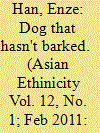

|
|
|
|
|
| Publication |
2011.
|
| Summary/Abstract |
As one of China's five autonomous regions, Inner Mongolia has not been highlighted in the international news, and the Mongols have not demonstrated significant political will for greater autonomy in the way the Tibetans and the Uighurs have in recent decades. Why haven't the Mongols mobilized? This paper argues that the Mongols' lack of aspiration for greater autonomy is in part due to the relationship between Inner Mongolia and Mongolia as an independent kin state. The different trajectories of national identity construction in these two places and the perception of better living conditions in Inner Mongolia have made the Inner Mongols less anxious about their current incorporation within the Chinese state.
|
|
|
|
|
|
|
|
|
|
|
|
|
|
|
|
| 4 |
ID:
097809
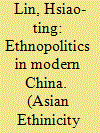

|
|
|
|
|
| Publication |
2010.
|
| Summary/Abstract |
This article reveals the murky political landscape of Alashaa Banner in Inner Mongolia during the Sino-Japanese war (1937-1945). By using various archival documents and secondary source materials, this research seeks to present a clearer picture of Inner Mongolian borderlands, involving the Chinese Nationalists, the Sinicized Muslims, and the Inner Mongols. Instead of restating the 'ineffectiveness' or 'weakness' of the Nationalist frontier administration in China's innermost borderlands during the pre-1949 decades, this article attempts to explore the extent of the war-threatened Nationalist Chinese effort to initiate their state-building tasks and promote their regime's power consolidation in modern China's northern periphery.
|
|
|
|
|
|
|
|
|
|
|
|
|
|
|
|
| 5 |
ID:
128345
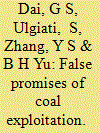

|
|
|
|
|
| Publication |
2014.
|
| Summary/Abstract |
The grasslands of Inner Mongolia are not only the source of the necessary resources for the survival and development of herdsmen, but also represent a significant green ecological barrier in North China. Coal-mining production is important in maintaining GDP growth in Inner Mongolia. However, over-exploitation has created serious problems, such as pollution of the environment and significant decreases in grassland ecosystem services, in addition to impacting the well-being of herdsmen and other humans. Based on questionnaires survey performed among 864 herdsmen addressing the relationship between coal exploitation in grasslands and human well-being in Xilinguole League in Inner Mongolia, we found that (1) coal resource exploitation in these grasslands does not benefit the herdsmen by increasing their income; (2) the rapid development of this resource has not obviously materially improved the life of the herdsmen; and (3) these activities have increased the risks that herdsman will have to endure in the future. Overall, coal resource exploitation in grasslands has more negative than positive effects on the well-being of herdsmen. We propose the conservation of coal resources and improvement of ecological compensation should be carried out without blindly pursuing economic growth, instead of focusing on economic development and structural adjustments.
|
|
|
|
|
|
|
|
|
|
|
|
|
|
|
|
| 6 |
ID:
097813
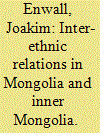

|
|
|
|
|
| Publication |
2010.
|
| Summary/Abstract |
The article deals with the development of minority policies in Mongolia since independence from China, and focuses on the effects that these policies have had on inter-ethnic relations. The main groups studied are the Khalkha Mongols, the Kazakhs, the Tuvans and the Han Chinese. The definitions of these groups as either u ndesten or yastan have also varied over time, which has created theoretically interesting complexities. The article contains a sociolinguistic study of the inter-ethnic relations, with particular emphasis on education, culture, media and publishing. Furthermore, the tendency of the Tuvans to identify ethnically with the Mongols rather than with the Kazakhs is analyzed from the point of view of a sub-minority-majority identification theory. In Inner Mongolia, the inter-ethnic relations are problematic, and there are also severe tensions between the Mongols of Inner Mongolia and those of Mongolia. These ethnic policies have also played an important role in the development of the inter-state relations between Mongolia and the People's Republic of China.
|
|
|
|
|
|
|
|
|
|
|
|
|
|
|
|
| 7 |
ID:
115238
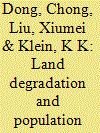

|
|
|
|
|
| Publication |
2012.
|
| Summary/Abstract |
Overgrazing in the grasslands of Inner Mongolia following market reform in China has led to severe soil degradation and desertification. In an effort to revive the ecological environment in northern pastoral areas, the government of China recently adopted an intervention policy to relocate families from areas where excess grazing pressure was seriously compromising land and the environment. A survey was conducted in three villages to determine how well the relocated families have adapted to their new living conditions and the factors that affect their willingness to stay in the new villages. Regression analysis revealed that the most important factors were age of the head of the household, length of time the family has resided in the new village, proportion of total income that is made up of government payments and level of fixed, durable and current assets.
|
|
|
|
|
|
|
|
|
|
|
|
|
|
|
|
| 8 |
ID:
187224
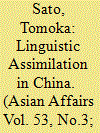

|
|
|
|
|
| Summary/Abstract |
Recent news about China's attitude the human rights of Uighurs in Xinjiang and its crackdown on civil liberties in Hong Kong has drawn a great deal of attention in the western media, with China facing a barrage of criticism from that source. Shortly before these developments came to light, China was taken to task over violence against Tibetans, which some viewed as cultural genocide. In contrast, the plight of Inner Mongolians is not widely known. In 2020, the Chinese government announced a new language policy promoting immediate Mandarin-language education in schools in the region. This shows how actively China has been eradicating the identity of peripheral minority groups. This article begins with a brief historical overview of China's linguistic assimilation policy toward ethnic minorities, followed by an investigation based on existing research and media information on the current position in Inner Mongolia and in particular of Mongolians living in Japan.
|
|
|
|
|
|
|
|
|
|
|
|
|
|
|
|
| 9 |
ID:
192503


|
|
|
|
|
| Summary/Abstract |
This paper examines the effect of the Mongolian nationality factor on Chinese-Mongolian relations and the actions of the PRC leadership in connection with the need to consider this factor in domestic policy, especially in the Inner Mongolia Autonomous Region (IMAR). Special attention is given to the ethno-cultural reasons for and the conditions of the problems inhibiting the stable development of bilateral relations between China and Mongolia: the existence of worldwide pan-Mongolian and nationalist movements, the dispute over the status of the 14th Dalai Lama, China's efforts to appropriate symbols of traditional Mongolian culture, and the commercialization of Genghis Khan's image.
|
|
|
|
|
|
|
|
|
|
|
|
|
|
|
|
| 10 |
ID:
180075
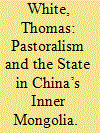

|
|
|
|
|
| Summary/Abstract |
The Chinese government has downgraded use of the Mongol language in schools in the Inner Mongolia Autonomous Region, and is now using its brand of state environmentalism to rein in Mongol pastoralists, blaming them for the degradation of grasslands. By targeting language and land use, the two pillars of Mongol autonomy, the state has shown that it is prepared to override the very limited forms of autonomy still enjoyed by China’s minority nationalities. Mongol leaders are responding by working within the state and its discourses to preserve pastoralism, casting herders not as keepers of a timeless nomadic culture but as partners in preserving biodiversity and stemming desertification.
|
|
|
|
|
|
|
|
|
|
|
|
|
|
|
|
| 11 |
ID:
181902
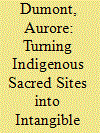

|
|
|
|
|
| Summary/Abstract |
Oboo cairns are sacred monuments worshipped by minority peoples in Inner Mongolia. The inclusion of oboo worship on China’s national list of Intangible Cultural Heritage in 2006 has caused negotiations and innovations in different social and ritual strata of local societies. Going from provincial decision-making to the local interpretation of heritage classification, this article examines how the indigenous intelligentsia and ordinary people appropriate oboo to make them valuable and powerful sacred monuments.
|
|
|
|
|
|
|
|
|
|
|
|
|
|
|
|
|
|
|
|
|